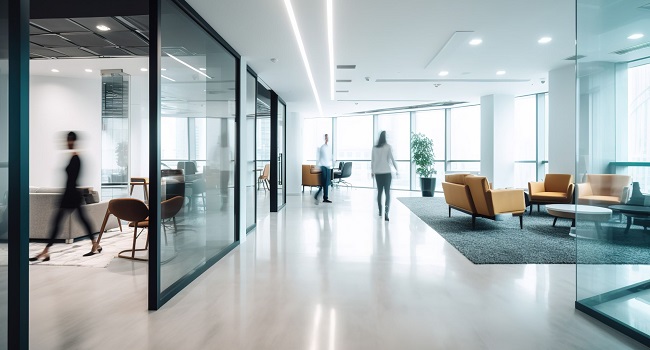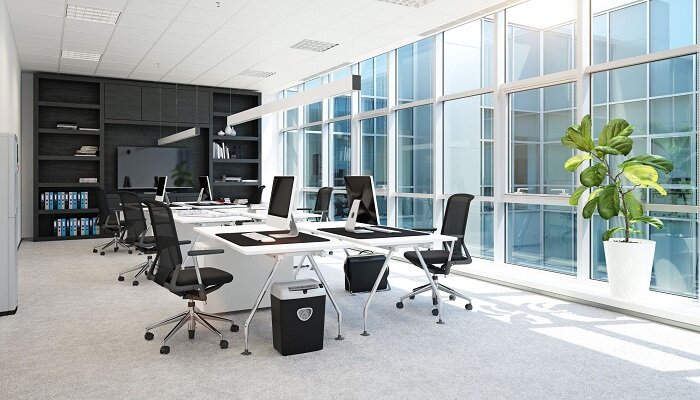The world is gradually waking up to the importance of sustainable living, and businesses are no exception. From the materials they use to the energy they consume, companies are now actively seeking ways to reduce their carbon footprint and positively impact the environment. Sustainable office lighting is one of the most effective ways to achieve this. Not only does it help cut down on energy usage and reduce costs, but it can also improve the health and well-being of employees and boost productivity levels.
Gone are the days of harsh fluorescent lighting and uninspiring office spaces. Modern sustainable office lighting ideas are now innovative, creative, and beautiful, with various options for different work environments. Whether maximizing natural light, installing energy-efficient LED bulbs, or incorporating smart lighting controls, there are countless ways to make your office lighting more sustainable.
So, if you’re looking to create a greener workplace that enhances productivity and promotes a healthier lifestyle, here are sustainable office lighting ideas that every business owner should consider:
1. LED Lighting
LED lights have become increasingly popular, revolutionizing the lighting industry, especially in the workplace. Not only are these lights an energy-efficient and cost-effective solution for businesses, but they also offer a range of other benefits that make it a practical choice.
For instance, LED lights emit less heat than traditional lighting, which creates a more comfortable work environment, especially during the summer months. They also produce a consistent, flicker-free light that can help reduce eye strain and headaches, improving the overall well-being of employees. This is particularly important in workspaces that require long hours of screen time.
Another benefit of commercial LED lighting is that it can be integrated with intelligent lighting systems to maximize energy savings and provide a personalized lighting experience. For example, businesses can use occupancy and daylight sensors to adjust lighting levels according to the needs of the space and occupants. This can help reduce energy consumption, lower costs, and improve the overall sustainability of the business. Moreover, with the ability to control the color temperature and intensity of the light, businesses can create a comfortable and inviting work environment that boosts productivity and creativity.
To make the most out of LED lighting, consider installing dimmer switches, which allow for more precise control over the lighting levels. Additionally, regular maintenance and cleaning of the fixtures can ensure optimal performance and energy efficiency. With these tips, businesses can reap the benefits of LED lighting while contributing to a more sustainable future.
2. Natural Light
Natural light is an often-overlooked aspect of sustainable office lighting, yet it has many benefits that cannot be ignored. Exposure to natural light has been shown to increase productivity, improve mood, and reduce eye strain and headaches. In addition, utilizing natural light reduces energy usage and cost, making it a win-win for both the environment and your company’s bottom line.
If your workplace lacks natural light, there are several ways to increase its presence. For instance, adding skylights or large windows can help bring in more natural light while adding an aesthetic appeal to the workspace. Additionally, you can consider using light-reflecting materials such as light-colored paint, mirrors, or even solar tubes to help bounce natural light into darker areas of the office.
3. Motion Sensors
Integrating motion sensors into the workplace lighting system can be an intelligent choice for businesses that want to conserve energy and lower expenses. Motion sensors automatically detect the presence of people in an area and turn on the lights, eliminating the need to keep them on all day. This not only saves energy but also increases the lifespan of the lighting system.
For instance, you can install motion sensors for high-traffic areas like restrooms, break rooms, and conference rooms to ensure that lights are only on when necessary, leading to significant energy and cost savings.
In addition to the environmental and financial benefits, motion sensors can also help improve the overall functionality and convenience of the workplace since employees no longer have to worry about turning the lights on and off when entering or leaving a room.
4. Task Lighting
Task lighting is a popular lighting strategy for offices, as it is cost-effective, energy-efficient, and provides focused illumination where needed the most. Rather than lighting the entire room, task lighting uses individual light sources to illuminate specific work areas, reducing energy consumption and enhancing productivity. These lights include desk lamps, under-cabinet lights, or other fixtures that provide localized lighting.
Task lighting is particularly effective in reducing eye strain and improving focus for employees who spend long hours at their desks. Employees can better see what they’re working on by directing light onto the specific task without being distracted or bothered by harsh overhead lighting.
On the other hand, you can also utilize task lighting to highlight certain areas in the office, such as artwork or decor, adding an extra level of interest and depth to the workspace.
5. Smart Lighting
Innovative technology has allowed businesses to take their lighting to the next level with smart lighting systems. These systems use innovative technology to detect occupancy, daylight levels, and time of day to adjust lighting levels automatically. By doing so, they can significantly reduce energy consumption and costs while also improving the overall work environment.
One of the most significant advantages of smart lighting systems is their ability to be customized. With smart lights, you can program them to turn on or off, as well as adjust their tone and color. You can also customize lighting levels based on the time of day. For example, when natural light is limited during the early morning and late afternoon, the system can provide brighter lighting to help employees stay alert and focused. Conversely, when natural light is abundant in the afternoon, the system can lower the lighting levels to reduce energy consumption and create a more relaxed atmosphere.
In Conclusion
Embracing sustainable office lighting ideas can significantly promote a greener and more efficient workspace. By implementing strategies like LED lighting, maximizing natural light, installing motion sensors, providing task lighting, and using smart lighting systems, businesses can enjoy a more sustainable and eco-friendly solution that helps them save on operating costs.

Moreover, these lighting ideas can offer the added benefit of creating a more pleasant and productive workspace for employees. Ultimately, these small yet practical steps can contribute to a more sustainable future while improving your bottom line.





































